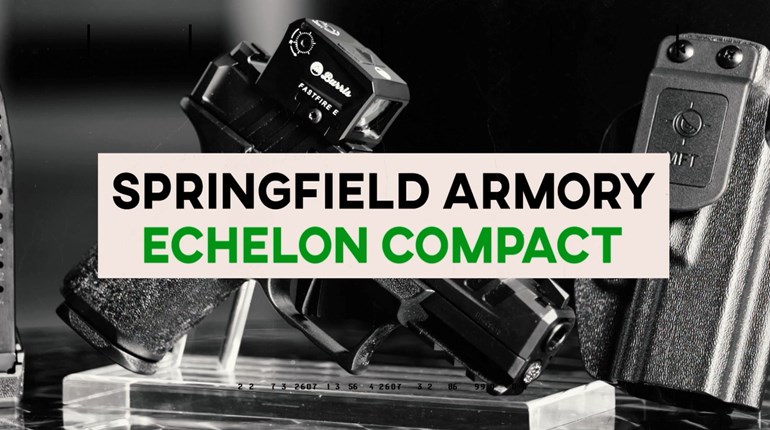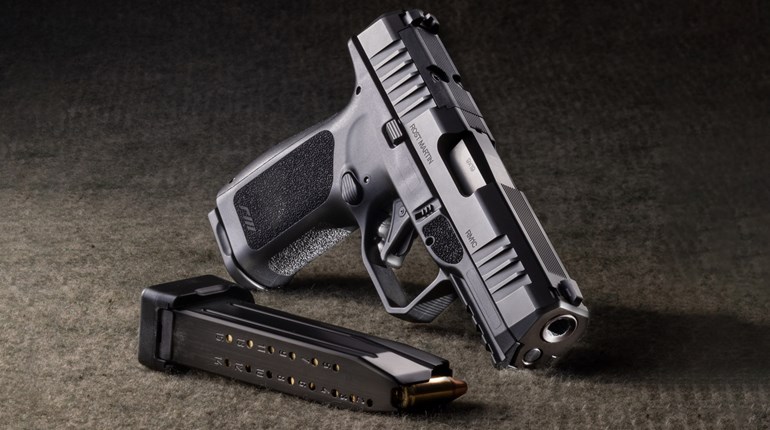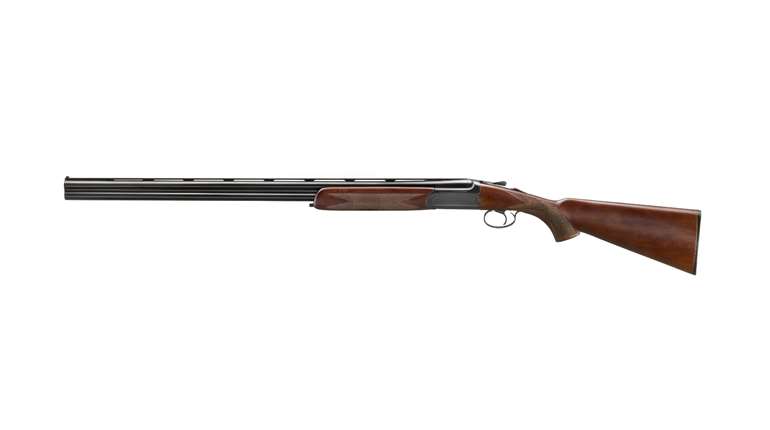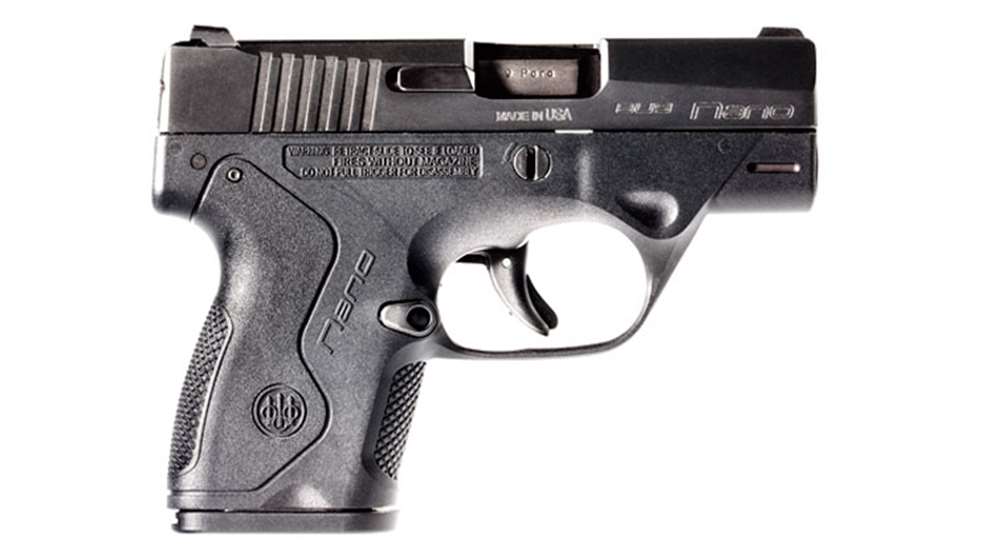
There have been a number of new micro-compact pistols introduced in the last couple of years that have dramatically improved the performance levels of super-concealable handguns. Where the standard of performance for pocket pistols used to be the old .380 ACP cartridge in a blowback semi-automatic, the new generation of locked-breach self-loaders is firing 9 mm +P ammo in a wide variety of bullet weights with total reliability and controllability.
In addition to their incredibly robust designs, some of these pistols have features that are both functional and uniquely creative. The newest member of this genre is Beretta's 9 mm Nano.

Typical of today's 9 mm handguns, the Nano is a striker-fired, locked-breech, recoil-operated pistol. Overall length is 5.63 inches, while overall height is 4.17 inches. Grip width and overall width are a mere .9 inch. Although it doesn't look all that compact, dimensionally this is a small gun. It is not, however, the lightest micro on the market, with an unloaded weight of 17.67 ounces.
Slide and barrel are both steel with a black Nitride finish, which will probably outlast its owner. The inner frame/chassis is stainless steel, while the grip frame is fiberglass-reinforced technopolymer. (Recognizing the enhanced toughness of today's polymers, I still long for the days when we just said "plastic.") Giving credit where it's due, I would have initially guessed the grip was made of a hard-anodized-aluminum alloy, and I liked both the look and feel of it.
The frontstrap and backstrap sections of the grip have molded rough surfaces that look almost like the checkering on metal guns and greatly enhance control. The grip received much more of my attention during the actual range sessions, but even in the initial handling and examination, I was impressed with the overall ergonomics of such a small handgun. Moreover, several shooters immediately commented on the excellent grip angle and the gun's natural pointing characteristics. When we raised it to eye level, the sights were on target.
While it's not the first thing you notice about the gun, the Nano has a unique modular design. Specifically, it has an inner frame (called the sub-chassis) that carries the pistol's serial number and holds the firing mechanism. The serial number is visible through a window cut into the polymer frame. You can remove the chassis and replace the outer grip frame with an alternate unit. While this feature may not have much relevance at this point in time, it will be interesting to see what alternatives Beretta offers in the future. To the best of my knowledge, the Nano is the only micro-compact pistol with this option.
The gun has a truly sleek, snag-free design with no protruding external controls save the magazine-release button, which is quite small and reversible in case you're left-handed. The typical externally mounted slide stop is internal on the Nano. It reliably locks the slide back when the last shot is fired, an unmistakable cue to reload. It is the magazine follower that activates the slide lock, which means an empty magazine must be in the gun for the slide to lock open—you can't do it manually. There are two ways to release the slide; insert a loaded magazine and pull the slide rearward, or remove the empty magazine and pull the slide rearward. Again, there is no lever, so these are the only means to release the slide. Serrations at the rear of the slide assist in this operation. As intended in a concealed carry handgun, this is a "pull, point and shoot" pistol.
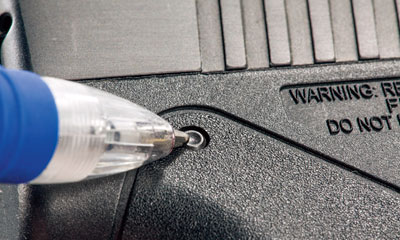
As mentioned, the Nano is striker fired. It has both a striker safety block and a trigger-drop safety. Beretta has a good explanation of how the striker system (and specifically the internal striker safety block and trigger-drop safety system) works in the instruction manual.
Also in the category of safety features, the manual describes the striker-deactivation button, which enables the user to disassemble the pistol without pulling the trigger. The manual doesn't actually say so, but this is clearly a design feature meant to address negligent discharges experienced when users have pulled the trigger to disassemble another popular striker-fired pistol without first checking to ensure it's unloaded.
Unquestionably, not having to pull the trigger during disassembly is a good thing, but recognize it does have a price. Disassembly is not as simple as with some other handguns. You now have an extra step in the disassembly process, two extra parts to deal with and a separate tool to use. I'm all for safety, but I prefer safety designs that are engineering driven as opposed to those generated in the legal department or dictated by politicians under the guise of making their constituents feel good.
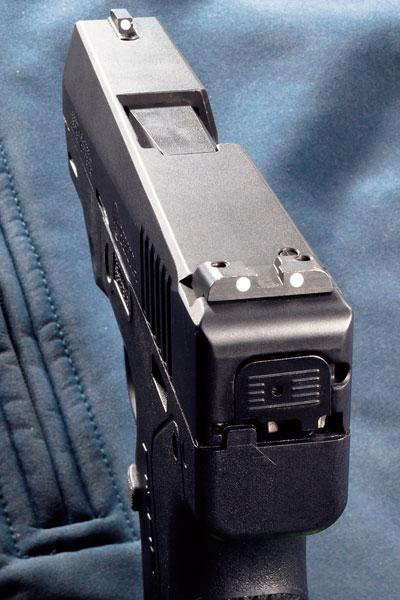
I was impressed with the Nano's low-profile sights. They are the fairly traditional three-dot, quick-acquisition design, and they work extremely well for being so compact. In bright light, the conventional blade-in-notch sight picture was quite crisp and precise—not always the case for sights this small. In any reasonable light level against a dark background, I found the white dots to be easily and quickly acquired, even when not wearing my DeCot shooting glasses with the "cheater" inserts. I know we should always wear protective lenses when shooting, but you don't get to choose when and where trouble will find you. If you're farsighted and don't conduct your daily business wearing prescription lenses, Murphy's law practically guarantees you will not be wearing glasses when a predator engages you.
Another excellent quality of the Nano's sights is they're removable, which provides two advantages. First, by loosening the two screws on the rear sight, you can adjust for windage. Given reasonable care installing the sights at the factory, I don't consider this is a mandatory feature on a pocket pistol, but considering the variety of defensive 9 mm loads available in today's market, adjustable sights are certainly nice to have if they can remain as small as the Nano's. Second, being easy to remove, they will be easy to replace should you desire something like XS Sight Systems' night sights. I don't know if the company has sights in stock for the Nano as I write this, but given its extensive outreach program, I suspect it will likely have a Big Dot available by the time you read this.
My test gun was delivered with two magazines, typical of what many permit holders carry—one in the gun and a spare. The Nano's magazines are single stack, which is the right approach for a pocket pistol because it minimizes the grip dimensions and helps those with smaller hands hang on to the gun and control recoil. There are witness holes in the side of the magazines, and when you can see the brass cartridge case in the bottom hole, you have reached Beretta's stated magazine capacity of six rounds.
Interestingly, both magazines would actually hold seven cartridges, and with the slide locked back in the open position, I could insert the overloaded magazine, drop the slide, and the gun functioned and cycled perfectly. With the slide in the forward position, however, I could not force an overloaded magazine all the way into the frame to achieve magazine lock. It didn't matter if there was a round in the chamber or not—the seventh round protruded from the top of the magazine just enough so the gun would not accept the magazine with the gun in battery. If you shot the gun to slide lock, you could reload with a magazine holding seven rounds. If you tried to top off the gun or perform a tactical reload, only six rounds (or fewer) in the magazine would work. It's a simple mathematical message. By loading an initial seven-round mag with the slide locked back, you'll have one in the chamber, six more in the magazine and a six-round reload in your pocket. That's either three or eight more rounds than you have available for a pocket revolver.
Plan to practice reloading the Nano, however. The gun's short grip means the heel of your shooting hand will be wrapped around the bottom of the gun, preventing an empty magazine from sliding free. You'll probably have to use the support hand to assist in stripping the magazine from the gun and change the grip of your shooting hand to insert the fresh magazine. No whining; with a little training and practice, the Nano's reload can still be much faster than a small revolver.
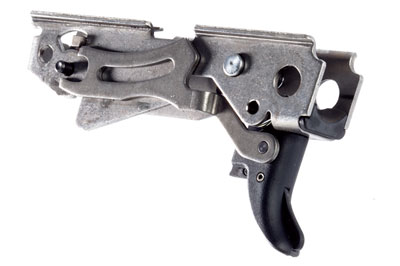
As I headed for the range to begin shooting, I had a couple of reservations about the new compact. The shape and dimensions of the grip do not allow the shooting hand to get as high into the gun and in line with the bore axis as is generally recommended. Since the grip's frontstrap was only large enough to accommodate the middle two fingers of my right hand, I felt it might be difficult to maintain a proper shooting grip during rapid fire, and controlling the little gun's recoil would be tough. In addition, I did not expect to have a really fun time. Once again, I was wrong on both counts.
I started the formal range testing a bit differently with the Nano, beginning with a bag of leftover 9 mm ammo from other activities. Brands and loads included all of the ammo chronographed, with the exception of Hornady's Zombie Max loads. Making sure all of the different brands were randomly included in the first few magazines, I cut loose at a rapid, but controllable, rate of fire on a less-than-full-size metal silhouette 15 yards away, a distance some folks consider long range for a gunfight. With a center mass hold, the results were excellent. Two shots sailed a bit to the right, which was definitely my fault. Some shots went low, likely caused by my getting acquainted with the Nano's long trigger pull rather than just being different impact points resulting from the wide range of bullet weights involved. There were no malfunctions or stoppages, either during this initial run or during the rest of the day, when two local police instructors assisted me in putting more than 300 rounds through the micro-compact. The Nano didn't care what bullet weights were used, nor did it show any hesitation with the +P loads. It was well behaved and functioned perfectly with the entire diet.
With just two fingers securing the grip, it was relatively easy to run through an entire magazine without having to shift or resecure my grip, but it took some time to get used to what seemed like the Nano's exceptionally long trigger pull. Things were made much easier by the fact that the trigger is extremely smooth throughout its entire length of travel.
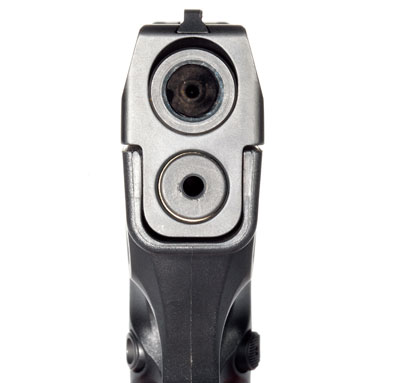
Afterward, we were able to make hits on the silhouette target at 50 yards—not with every shot, but frequently. We were also able to make head shots at 15 yards. Both the 50-yard shots and head-shot hits required maintaining concentration throughout the entire trigger pull, but even in our relatively short shooting session, each of us noticed improvements in our performance. A couple of subsequent, less formal outings with friends resulted in equally impressive 15-yard results and favorable testimony for the little Beretta powerhouse.
The Nano is definitely a concealed-carry pistol designed for self-defense. The fact it has no magazine disconnect and can be fired with the magazine removed (features that may make the gun unavailable in some states), indicates the designers had serious intentions about personal protection. How you choose to carry this newest micro-compact may depend more on your selection of clothing than on your personal preferences. I could not get the gun in and out of the front pocket on my jeans, and depen-ding on what brand of tactical trousers you wear, an inside-the-waistband carry might be most appropriate. Which leads me to wonder if Beretta already had a marketing plan in place during the pistol's design phase that includes the company's clothing line.
Nah, the Nano is too much of a fighting gun to have been influenced by the fashion police.
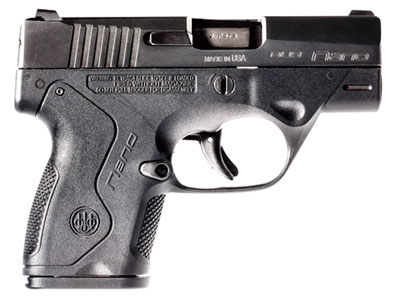
Specifications
Manufacturer: Beretta USA; (800) 929-2901, berettausa.com
Action Type: Recoil-operated, semi-automatic
Caliber: 9 mm
Capacity: 6+1
Frame: Polymer
Slide: 4140 steel
Barrel Length: 3.07 inches
Rifling: 6 grooves; 1:15.75-inch RH twist
Sights: Fixed; two-dot rear, red fiber-optic front
Trigger Pull Weight: 6 pounds, 8 ounces
Length: 5.63 inches
Width: .9 inch
Height: 4.17 inches
Weight: 17.67 ounces
Accessories: Hard-plastic case, manual, spare magazine
MSRP: $475
Shooting Results
| Load | Velocity | Group Size | ||
| Smallest | Largest | Average | ||
| American Eagle 147-grain FMJ | 863 | .62 | .89 | .75 |
| Federal Guard Dog Home Defense 105-grain EFMJ | 1,127 | .91 | 1.06 | .92 |
| Remington HD Ultimate Home Defense 124-grain BJHP | 1,037 | .45 | 1.25 | .76 |
Velocity measured 10 feet from the muzzle for 10 consecutive shots using a CED M2 chronograph. Temperature: 81 degrees Fahrenheit. Accuracy measured in inches for five consecutive, five-shot groups at 7 yards from a sandbag rest.














